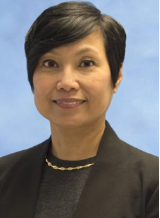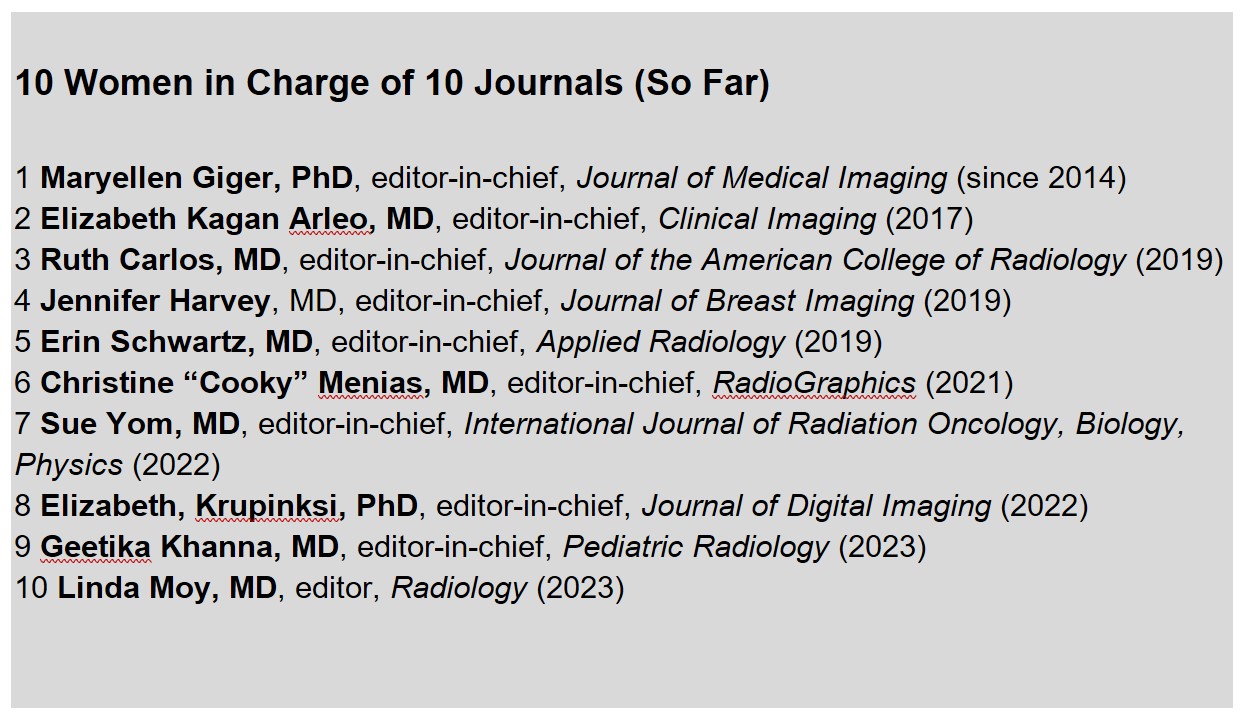Women editors of radiology journals: ‘Not a curiosity but a fact’
Women now fill the top editorial spots at 10 peer-reviewed radiology journals. Just like that, a new set of gatekeepers is shaping the conversation around scientific inquiry and discovery across much of medical imaging.
What fresh perspectives might these formidable women bring to radiology publishing? What, if anything, do they want the world to know about their personal journeys?
Radiology Business (RB) sought to find out. Focusing on how they became editors-in-chief, what they want to accomplish with the journals they run and why it matters that women are represented at the top, we learned a lot from several of these trailblazing women.

Maryellen Giger, PhD
"When I see someone really good, I get them involved—because I've learned that if you get involved with society leadership, you learn so much, you network so much, and you learn all across all different aspects of your field. When they say, ‘Thank you, how can I repay you?’ I say, ‘Pay it forward.’"
Beating Imposter Syndrome
Imposter syndrome can rear its ugly head for men and women alike, but it can be even more difficult to beat back self-doubt without easily identifiable role models. All of the female editors we spoke with mentioned that they didn’t put their names forward for leadership positions until they were specifically asked to do so by someone else.
That was the case for Maryellen Giger, PhD, who became the first woman to hold the role of editor-in-chief at a radiology journal in 2014. That’s when she stepped into the top spot at the Journal of Medical Imaging.
Giger got involved after a colleague asked her to run for the board of directors of the International Society for Optics and Photonics (SPIE). She originally assumed herself to be just a “filler” candidate.
“I was being very cynical; I’m thinking, they want eight people to run for four slots, and they already have the four people they really want,” Giger tells RB, laughing. “So I said, ‘Sure, I’ll help you out. I’ll run.’”
Her win of a role on the SPIE board was only the beginning. Two years later, fellow board members asked her to run for president. Again she agreed—and again she won.
As SPIE president, one of her duties was to lead the search for an outside candidate to head up the then-fledgling Journal of Medical Imaging. More than one candidate proposed an idea she hadn’t even thought of: The best person for the job might be none other than Maryellen Giger.
“I had never even thought of myself,” Giger tells RB. “But they kept throwing it back at me, saying, ‘No, you should do it.’”
After some consideration, she agreed to apply on the condition that the selection committee thoroughly vet her as they would any other candidate.
They did, and the rest is a key development in the history of women radiology editors.

Ruth Carlos, MD
“I work really hard to call out and recognize research performed by women—to speak their names out loud, referring to them by name to amplify their voices."
Leaning Into Opportunity
Ruth Carlos, MD, editor-in-chief of the Journal of the American College of Radiology, also struggled with a strain of imposter syndrome. She almost turned down an offer from that publication to take on the duties of deputy editor.
The previous JACR editor-in-chief “had been a mentor to me even before I joined the journal. He asked me to be his deputy editor in order to expand our social media portfolio,” she recalls. “Being of a certain generation—I’m a Gen Xer—I did not feel that I was sufficiently adept at social media to help him grow in that particular area. At first I actually turned him down for the position.”
The wise editor didn’t let her off the hook that easily. He asked her to go home and seriously mull the opportunity.
“I like to innovate. I like to work at the edge and do things other individuals or groups haven’t done before,” Carlos says. “I took the JACR post largely as an opportunity to apply that spirit.”
 Elizabeth Kagan Arleo, MD
Elizabeth Kagan Arleo, MD
"I’ve been the recipient of very generous and impactful mentorships, so I really strive to pay it forward in mentoring the next generation of radiologists—whether that's in one-on-one meetings, talking about professional goals or the intersection of personal life and how to balance it all."
Also initially disinclined to see herself as an editorial leader was Elizabeth Kagan Arleo, MD, editor-in-chief of Clinical Imaging. She shares that she never imagined herself that post—until the day she got the offer.
“Honestly, I had never thought about it before then. Maybe that’s because I had never seen a female editor-in-chief of a radiology journal,” Arleo says.
“That’s why it’s important to increase the number of women leading radiology journals, because hopefully they’ll be role models for the next generation coming up the pipeline,” she said.
Increasing Impact
While greater male/female diversity in the publishing world is worthwhile in its own right, there is, of course, much more to celebrate about women radiology editors than their womanhood. A key focus and accomplishment for the editors with whom Radiology Business spoke: driving impact—literally.
When Carlos began her working relationship with JACR as an author, she noticed the journal lacked an impact factor. She chose to publish with them because she so firmly believed they could directly help radiology practices. What’s more, in JACR she saw a vehicle for disseminating material that was less clinically oriented and more practically applicable.
That capability appealed to Carlos, who predicted JACR would have an impact factor to reckon with sooner rather than later. She was right—under her leadership, the journal recently scored an impact factor of 6.2. (This means its articles are cited an average of 6.2 times each per year.)
“It’s been very gratifying to be part of the journal and to see how it has evolved and matured into an indispensable part of radiology practice,” Carlos tells RB.
Taking Good Risks
At Clinical Imaging, Arleo has been working with similar determination on impact factor. Her No. 1 priority for 2023 is to boost that number from its current 2.42—which is already up from just 1.0 when she became EIC in 2017.
“I’m really gratified by this growth and want to continue on this trajectory,” Arleo says.
While Giger keeps an eye on impact factor at the Journal of Medical Imaging, she says that her top priority is sustaining the journal’s commitment to quality. She notes the publication’s consistent and relatively low 40% acceptance rate as well as her personal perusal of every paper that gets published.
“When we started this journal, we took a big risk by deciding that we would only accept high-quality papers. That was the most important thing to us,” Giger remembers. “Impact factor would follow, we said. And now our site score is very competitive to journals that have been out there for 50 years.”
While women editors—and women radiologists, for that matter—still find themselves outnumbered, the momentum is there to build on.
And while the women RB spoke with are pleased to set an example, all express hope that, in the future, people will pay attention to women editors primarily for their particular contributions; and not at all for their immutable identity.
As Carlos puts it: “I am optimistic the day will come when we’re viewed not as a curiosity but as a fact.”

